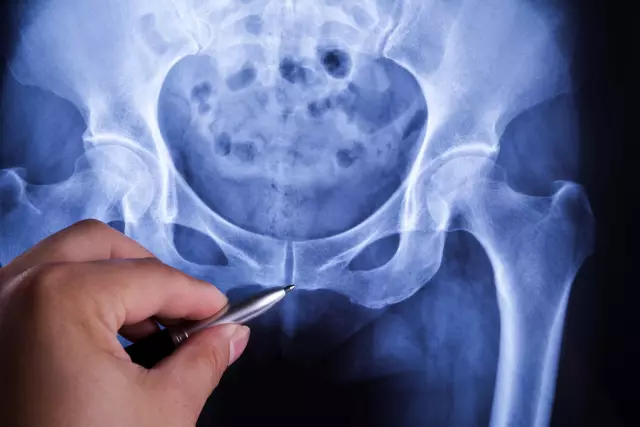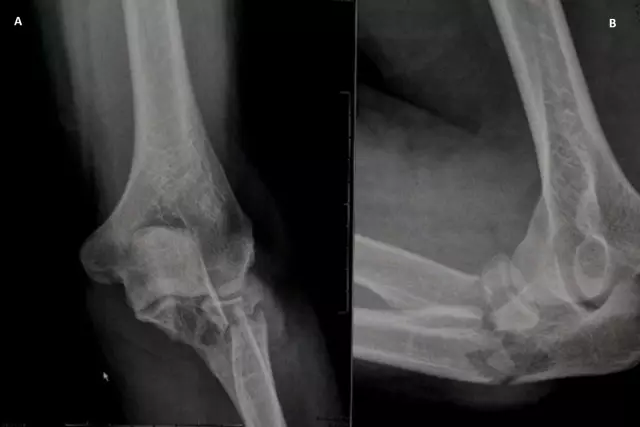- Author Rachel Wainwright [email protected].
- Public 2023-12-15 07:39.
- Last modified 2025-11-02 20:14.
Tailbone fracture

A tailbone fracture is a common and severe injury to the lower spine that causes severe pain, swelling, and inflammation.
Causes and symptoms of tailbone fracture
The tailbone is located in the lower part of the human spine and is a tail section that has ceased to form in the process of evolution. The most common injury to this section is a fracture.
The main cause of a tailbone fracture is an injury resulting from a fall, a direct blow to the buttocks, or during childbirth. A tailbone fracture is usually an adult injury, and dislocations are common in children.
Symptoms of a tailbone fracture are pain, swelling at the site of the fracture, inflammation, and difficulty in movement.
The most common causes of a tailbone fracture include:
- falls on the buttocks;
- impacts in a road traffic accident;
- sports injuries;
- long cycling, snow scooter and sleigh rides;
- lack of calcium and bone fragility;
- birth trauma;
- trauma during intercourse;
- dysfunction of the muscular apparatus.
In traumatology, a tailbone fracture is classified according to the following types: with and without displacement, articulated fracture, with a change in the position of the coccygeal vertebrae.
After the injury, symptoms of a tailbone fracture appear, including pain in the tailbone when walking and sitting, hematomas. An accurate diagnosis can be made with a radiograph.
In some cases, a tailbone fracture can occur in the presence of severe degenerative processes in the bones associated with calcium deficiency in old age.
Consequences of a tailbone fracture
Severe consequences of a tailbone fracture can be fragments, the presence of which can be detected with the help of rectal and vaginal examinations, X-rays and magnetic resonance imaging.
After determining the exact diagnosis, it is necessary to urgently start treatment, otherwise the following consequences of a tailbone fracture may occur:
- improper fusion of parts and fragments of the coccyx;
- dysfunction of the genitourinary system;
- violations of the defecation process;
- compression and violations of the pelvic organs;
- the appearance of growths and cysts on the tailbone;
- severe hematomas and suppuration;
- difficulties in movement and sitting;
- the formation of corns and fistulas;
- salt deposition and gout.
Coccyx fracture treatment
The method of treating a tailbone fracture depends on the type and severity of the injury, as well as the presence of complications and pathologies.

The main method of treating a tailbone fracture is conservative therapy, which is aimed at eliminating the main symptoms (pain syndrome, edema, inflammation). This therapy includes taking pain relievers and anti-inflammatory drugs, which are prescribed by the attending physician. If necessary, prescribe anti-inflammatory and decongestant ointments, compresses and tinctures.
The prerequisites for effective treatment of a tailbone fracture are bed rest for the patient and the exclusion of any stress on the spine. A rubber mattress or circle is placed under the patient's tailbone, and to avoid pressure sores, the patient is turned several times a day. In the first days of treatment, defecation is carried out only with an enema.
Surgical treatment of a tailbone fracture is prescribed for the following complications: serious displacement, improper fusion, compression of nerve endings and blood vessels by parts of the coccyx, severe pain syndrome that does not stop for a long time.
After the main course of therapy, the doctor prescribes rehabilitation procedures, including physiotherapy, massage, exercise therapy, electrotherapy and hirudotherapy.
After suffering a fracture of the tailbone for several years, the patient must observe a sparing mode of work and rest, avoid heavy loads on the lower spine, exclude horse riding and lifting heavy objects. After a tailbone fracture, athletes are prescribed a special training regimen with a gradual increase in loads, but in some cases professional heavy sports are canceled for several years.
In the presence of pathological and degenerative processes of the musculoskeletal system, special nutrition, gymnastics and vitamin therapy are prescribed to strengthen bone structures and muscular apparatus.
YouTube video related to the article:
The information is generalized and provided for informational purposes only. At the first sign of illness, see your doctor. Self-medication is hazardous to health!






